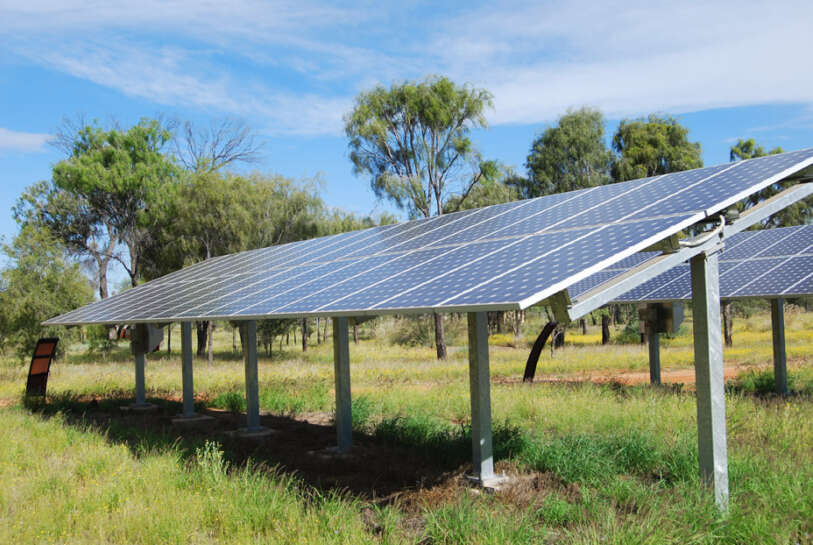| Manufacturer | Trina |
|---|---|
| Array Rating | 5.25kW |
| PV Technology | mono-Si |
| Array Structure | Fixed: Ground Mount |
| Installed | 2009 |
View on Map Graphs Download Data
Current Output

Trina monocrystalline silicon array, fixed ground-mount.
Monocrystalline panels convert sunlight at a high efficiency, and are often used where space is limited – such as on a large-scale tracking array.
This fixed ground-mount installation of Trina monocrystalline panels has the same configuration as the large-scale tracking arrays. Its performance can be compared to the trackers’ to confirm the gains contributed by the tracking system.
This fixed array is oriented in a position that will maximise its exposure to sunlight through the year. The panels are tilted at 20º from horizontal, close to Alice Springs’ angle of latitude. The array is directed due north.
Monocrystalline panels are manufactured from large silicon crystals sawn into single cells.
Solar Inception delivers complete photovoltaic power plants. They are distributors for Trina Solar, a photovoltaic manufacturing company based in China.
| Array Rating | 5.25kW |
|---|---|
| Panel Rating | 175W |
| Number Of Panels | 30 |
| Panel Type | Trina TSM-175DC01 |
| Array Area | 38.37 m² |
| Type Of Tracker | N/A |
| Inverter Size / Type | 6 kW, SMA SMC 6000A |
| Installation Completed | Thu, 8 Jan 2009 |
| Array Tilt/Azimuth | Tilt = 20, Azi = 0 (Solar North) |

Notes on the Data
-
Site 13: Combiner Box Replaced
Array 13 was isolated between approximately 8am and 11am on this day, while a weathered combiner box located at the array was being replaced to avoid risk of moisture ingress.
-
System Disconnection for Cabling Works
All arrays at the Solar Centre were disconnected from approximately 2.00pm to 3.00pm on Monday, 9 July 2018 in preparation for the cable between the main switchboard and distribution board being upgraded. Array sites #23-38 remained disconnected while the main feeder cable to these sites was replaced in subsequent days, but all systems were re-connected by early afternoon on Thursday, 12 July 2018.
-
Site 13: New Inverter
The inverter at this array was replaced with a new one of the same model at around 11am today, as the previous inverter had been experiencing transformer temperature issues. The array was briefly isolated at this time to enable the changeover.
-
Site 13: Output Disturbance
Disturbances in the power output of this array have been noted since Friday, 22 September. Troubleshooting is currently underway, and the array was disconnected at approximately 11am-noon on Friday, 6 October. Updates will continue to be provided on this webpage as the issue is resolved.
Update 27/11/2017. The system continues to have intermittent outages. The cause has been traced to over heating of the inverter. Remedial works have been carried out on inverter. These did not correct the problem and a new inverter has been ordered. The system will be left to operate until the new inverter arrives.
-
Site 13: Inverter Transformer Temperature
Intermittent output has been observed with the cause traced to a transformer temperature fault in the inverter. The SMA SMC 6000A inverter is currently being replaced.
-
Monitoring Interruption for UPS Battery Replacement
The disconnection and re-connection of the solar arrays and weather station equipment while a new site connection was being established prompted the already flattening UPS batteries which power the site’s energy meters to fail and require immediate replacement. Data recording was affected from approximately 2.30pm ACST, Monday 10 July to 4.00pm, Wednesday 12 July.
Affects weather data for DKASC, Alice Springs
-
Site 1A and 13: PV Module Discolouration
An orange discolouration of the majority of the PV modules on these arrays was noted in 2013. Investigation by the module manufacturer identified that the cause was the use of a particular back sheet material that on thermal and UV exposure has begun to breakdown and released the discolouring agent into the EVA. On these same arrays a several PV modules that utilized a different back sheet material have not been effected by this at all. Despite this discolouration no significant impact on the arrays performance has been noted to date. The module manufacturer did request to change out the effected PV modules, but for the benefit of the industry and to allow the progress of this issue to be observed over many years they kindly agreed to leave the majority of these PV Modules in place. The only PV modules that were changed out was the PV system now nominated as Site 1B, which was subsequently separated off as its own distinct array. Sites 1A and Site 13 retain the original PV modules.
> Answer to Spotlight Question
Onsite at the DKA Solar Centre in Alice Springs are a series of quiz-like Spotlight Questions at each array. Visit the centre and scan the QR code at each sign to test your knowledge – and check your answer here!
Q: How thick is the slice of silicon that makes up a solar cell?
A: Most crystalline solar cells are no more than half a millimetre thick; the typical thickness is 100-500 microns. It should be noted that the active layer of the cell is less than 60 microns, but crystalline silicon cells this thin would be too fragile to survive the manufacturing process so the additional thickness of the cells is needed to provide structural support. By contrast, thin film cells – which are made through a very different process to the crystalline silicon cells – are often less than 10 microns thick.
